#middle rhine valley
Explore tagged Tumblr posts
Video
"why wait / to say / at least i did it my way." por lina zelonka Via Flickr: bacharach (rheinland-pfalz, germany) *** instagram / tumblr
#bacharach#germany#lina zelonka#rheinland-pfalz#rlp#rhineland-palatinate#mittelrheintal#middle rhine valley#mittelrhein#middle rhine#architecture#deutschland#architektur#houses#hills#nikon d7100#18-140 mm#flickr
9 notes
·
View notes
Text

Hostel Burg Stahleck - DEUTSCHLAND
#hostel#burg#stahleck#castle#castillo#upper middle#rhine valley#bacharach#rhineland palatinate#deutschland#germany#alemania#europe#europa
48 notes
·
View notes
Text

🇩🇪 Sankt Goar and the Ruins of Rheinfels Castle as Seen from the Northeast - a coloured aquatint by Johann Ludwig Bleuler from 1840.
Nowadays, Sankt Goar is part of the UNESCO World Heritage Site - Upper Middle Rhine Valley in Germany.
#Sankt Goar#Johann Ludwig Bleuler#Rheinland-Pfalz#Germany#See The Rhine#picturesque#Fascinating Europe#RLP#Rhein#Rhine#Europe#art#vintage#artwork#Mittelrhein#Mittelreintal#Upper Middle Rhine Valley#castle#burg#Welterbe#World Heritage
5 notes
·
View notes
Text
Travel the World of Imagination: Journeys Beyond Border
Kieth Denmark M. Retes | BSIT1A OVERVIEW:
Switzerland originates from the Old Swiss Confederacy established in the Late Middle Ages, following a series of military successes against Austria and Burgundy; the Federal Charter of 1291 is considered the country's founding document. Swiss independence from the Holy Roman Empire was formally recognized in the Peace of Westphalia in 1648. Switzerland has maintained a policy of armed neutrality since the 16th century and has not fought an international war since 1815. It joined the United Nations only in 2002 but pursues an active foreign policy that includes frequent involvement in peace building.
Switzerland is the birthplace of the Red Cross and hosts the headquarters or offices of most major international institutions including the WTO, the WHO, the ILO, FIFA, the WEF, and the UN. It is a founding member of the European Free Trade Association (EFTA), but not part of the European Union (EU), the European Economic Area, or the eurozone; however, it participates in the European single market and the Schengen Area. Switzerland is a federal republic composed of 26 cantons, with federal authorities based in Bern. references: Switzerland - Wikipedia

Switzerland, a small yet influential country nestled in the heart of Europe, stands out in many ways. From its awe-inspiring landscapes to its unique political system, Switzerland offers a blend of natural beauty, cultural diversity, and global diplomacy that few other nations can match. Its distinct character is a product of centuries of neutrality, innovation, and a deep respect for its heritage, all of which contribute to the nation’s unparalleled reputation on the world stage.

One of the first things that captivates visitors to Switzerland is its breathtaking scenery. The country is dominated by the majestic Alps, with towering snow-capped peaks that attract adventurers and nature lovers from around the globe. Whether it’s skiing in world-class resorts like Zermatt and St. Moritz or hiking through verdant valleys and along crystal-clear lakes, Switzerland offers outdoor experiences that are hard to rival. Beyond the Alps, the country is dotted with picturesque towns, lush meadows, and sparkling lakes, such as Lake Geneva and Lake Lucerne, each offering their own unique charm. The country's commitment to environmental preservation further enhances the beauty of these landscapes, ensuring that they remain pristine for future generations.
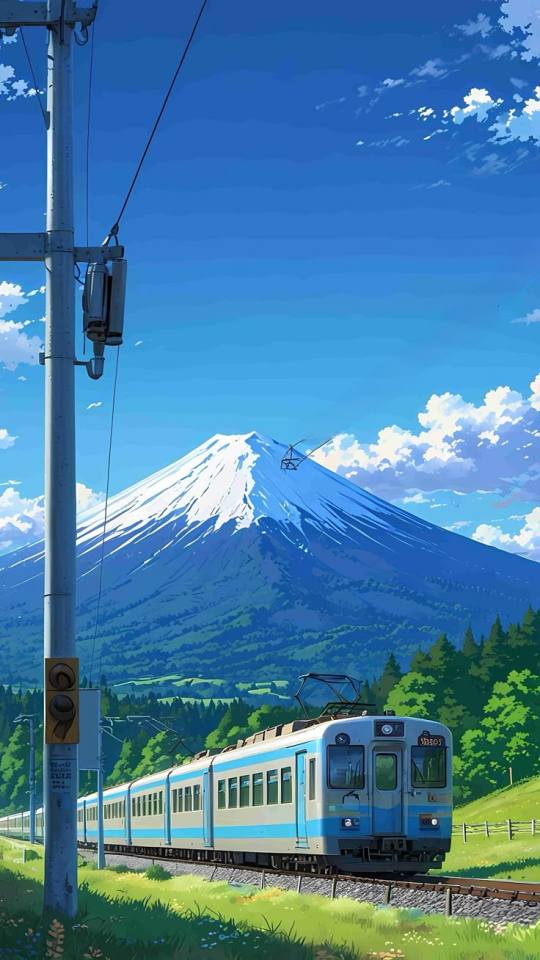
Swiss culture is characterized by diversity, which is reflected in diverse traditional customs. A region may be in some ways culturally connected to the neighbouring country that shares its language, all rooted in western European culture. The linguistically isolated Romansh culture in Graubünden in eastern Switzerland constitutes an exception. It survives only in the upper valleys of the Rhine and the Inn and strives to maintain its rare linguistic tradition.
Switzerland is home to notable contributors to literature, art, architecture, music and sciences. In addition, the country attracted creatives during times of unrest or war. Some 1000 museums are found in the country.
Among the most important cultural performances held annually are the Paléo Festival, Lucerne Festival, the Montreux Jazz Festival, the Locarno International Film Festival and Art Basel.
Alpine symbolism played an essential role in shaping Swiss history and the Swiss national identity. Many alpine areas and ski resorts attract visitors for winter sports as well as hiking and mountain biking in summer. The quieter seasons are spring and autumn. A traditional pastoral culture predominates in many areas, and small farms are omnipresent in rural areas. Folk art is nurtured in organisations across the country. Switzerland most directly in appears in music, dance, poetry, wood carving, and embroidery. The alphorn, a trumpet-like musical instrument made of wood has joined yodeling and the accordion as epitomes of traditional Swiss music.
references: Switzerland - Wikipedia
64 notes
·
View notes
Note
Apologies if this questions sounds stupid or ignorant, but I'm genuinely trying to educate myself. Can Jews be Jewish *and* a different race, so does a Jewish identity supersede another racial identity? Just wondering because a lot of Ashkenazi Jews I know (in real life or online) push back against the idea that they are white. I've heard European Jews say that they are not considered white, do not have white privilege, etc. so they are not white. But I've also seen a lot of Jews of color identify with both their Jewish identity and their "racial" identity (ravenreveals on Instagram explains how she identifies as Black *and* Jewish, and one of my friends identifies as an Asian Jew). So is there a reason many European (Ashkenazi?) Jews don't identify as white/identify as only Jewish? I'm sorry if this is offensive in any way, this isn't my intent :)
Sorry it took me so long to answer, I am swamped with asks haha
Yes, it's possible to be Jewish and a different race, as Judaism isn't a race, but an ethnoreligion, or even better described as a tribal nation.
Now, first I'm going to push back on you equating European with Ashkenazi. Ashkenazi is a specific term referring to Jews whose ancestors settled in the Rhine valley after the Roman expulsion from Judea. Many of these Jews eventually migrated eastward to Eastern Europe and Westward to British Isles, while others stayed in the Rhine valley region. But not all Jews whose ancestors settled in Europe are Ashkenazi.
There are Sephardi Jews, obviously, whose ancestors settled in the Iberian peninsula following the Roman expulsion, and then later migrated to North Africa, Northwestern Europe, Eastern Europe, and West Asia following the Spanish and Portugese inquistions.
There are also Italki Jews in Italy and Romaniote Jews in Greece, all of which are unique communities of Jews whose ancestors settled in Europe and who are not Ashkenazi.
Additionally, not all Ashkenazi Jews are racialized as white. Ashkenazi does not refer to your race, but rather who your ancestors are and/or what community traditions you follow. There are Ashkenazi Jews of every race.
The reason why lots of what-you-perceive-as-white Jews don't identify as white is because Judaism precedes the modern constructs of race (yes, race is a construct, not an immutable science) and because whiteness is highly subjective and fluid, just as non-whiteness is. Because race is a construct, which race a person is perceived as varies by where they are and by which people they are around.
Jewish "whiteness" is also conditional- and as Jews we don't like to leave ourselves vulnerable to shifting statuses. Jewish "white-passing-ness" can also be a tool of violence, either by denying the racial reality of antisemitism, or by being 'proof' that Jews are shape-shifting inflitrators of the white race. Hitler's Final Solution was total extermination precisely because he feared many Jews would pass as white and spread their Jewish blood among the Aryans, and so the total extermination of Jews was deemed as necessary, like one would exterminate a parasite.
This of course doesn't mean that no Jew has ever had access to the privilege afforded to whiteness. In the post-Holocaust era, many Jews have tried to successfully assimilate into whiteness to access even a little bit of privilege in order to protect themselves. I'm not going to lie and say that if I was pulled over at a traffic stop, my lighter complexion wouldn't give me more grace at the hands of the police officers than someone with darker skin would. Because yes, sometimes I am racialized as white and therefore access the privilege of whiteness.
But that doesn't mean I don't feel deeply uncomfortable when I'm filling out a form and the only options for race and even ethnicity are "white", "black", "hispanic", and "asian". Because while at the end of the day I'll check "white", it's only because I don't want to be accused of fraud (even though Middle Eastern or just Jewish would fit me better, but that's not an option). But that's just me. Some Jews are fine calling themselves "white Jews". Two Jews three opinions and all.
Someone introduced me to the phrase "racialized white/black/etc" a few years ago, and I think it makes much more sense. Because race is entirely dependent on perception and how others racialize you. I am not White, but sometimes I am racialized as white. Other times, I am racialized as "not-quite-white-but-we-don't-know-how-to-categorize-you-so-we're-just-going-to-try-and-guess-and-ask-wildly-invasive-questions".
At the end of the day, call Jews what they want to be called, and don't try and push labels on us. If a Jew doesn't want to be called white, don't call them white. Because race, ethnicity, religion, and all that is complicated, and Judaism predates all of that, so naturally Jews are going to have mixed feelings about it all.
#jumblr#race vs ethnicity vs haplogroup#judaism#jewish identity#jewish experience#if jew know jew know
276 notes
·
View notes
Text
Upper Middle Rhine Valley

Today, we’re diving into the heart of Germany to explore the breathtaking Upper Middle Rhine Valley, a region that’s more than just a picturesque landscape—it’s a UNESCO World Heritage site steeped in history, culture, and natural beauty.
In 2002, the Upper Middle Rhine Valley was recognized as a UNESCO World Heritage Site for its outstanding cultural landscape. The designation highlights the valley’s significance as a crossroads of history, art, and nature. The region’s preservation as a cultural landscape ensures that this unique blend of natural beauty and human achievement remains protected for future generations.
The Upper Middle Rhine Valley, stretching for about 65 kilometers between the cities of Bingen and Koblenz, is one of the most scenic stretches of river in the world. The Rhine River winds its way through steep, vineyard-covered hills, dotted with charming medieval towns, imposing castles, and romantic ruins. This landscape has inspired poets, artists, and composers for centuries, and it’s easy to see why.

One of the most striking features of the Upper Middle Rhine Valley is the incredible concentration of castles. There are more than 40 castles and fortresses along this stretch of the Rhine, each with its own story to tell. Some of the most famous include the medieval Marksburg Castle, which has never been destroyed, and the picturesque Rheinfels Castle, a massive ruin that once controlled much of the Rhine's trade.
No visit to the Upper Middle Rhine Valley would be complete without mentioning the Lorelei, a towering rock formation that has become one of the most famous symbols of the Rhine. According to legend, the Lorelei was a siren who lured sailors to their doom with her enchanting song. Today, visitors flock to this spot to take in the stunning views of the river and imagine the legends of old.
The valley is home to several historic towns and villages that seem frozen in time. Bacharach, with its half-timbered houses and vine-covered hills, is a favorite among visitors. St. Goar, situated at the foot of the Rheinfels Castle, offers panoramic views of the river and the surrounding landscape. And then there’s Rüdesheim, known for its lively wine taverns and the famous Drosselgasse, a narrow street filled with music and merriment.
The Upper Middle Rhine Valley isn’t just about castles and legends; it’s also one of Germany’s premier wine regions. The steep slopes are lined with vineyards that produce some of the best Riesling in the world. Many of the towns along the Rhine host wine festivals, where you can sample local vintages, enjoy traditional music, and soak in the convivial atmosphere.

The valley’s history dates back thousands of years, with traces of Roman settlements, medieval fortresses, and Renaissance architecture. This area has been a key transportation route for centuries, and its strategic importance is reflected in the fortifications that line the riverbanks. Exploring the Upper Middle Rhine Valley is like taking a journey through time, with each castle, town, and vineyard telling a piece of the story.
Visiting the Upper Middle Rhine Valley is an experience that combines history, nature, and culture in a way few other places can. Whether you’re cruising down the Rhine, hiking the hills, or exploring the quaint towns and castles, you’ll find yourself captivated by the valley’s timeless charm. And don’t forget to raise a glass of local Riesling to toast to the beauty of this UNESCO World Heritage site.
The Upper Middle Rhine Valley is more than just a scenic destination—it’s a living testament to the enduring connection between people and the landscape. If you’re planning a trip to Germany, make sure to carve out time to explore this enchanting valley.🏰🍇🇩🇪
14 notes
·
View notes
Text
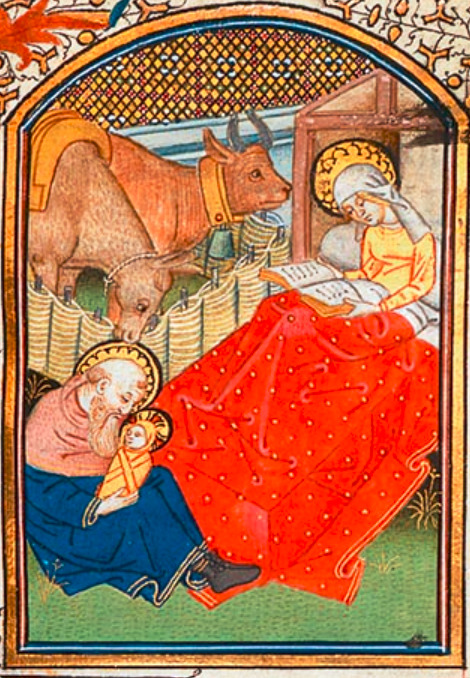
Joseph taking care of the Infant Christ while Mary studies Torah. Besançon Book of Hours, 15th Century.
German Christmas plays composed by and for devout laypeople in the late Middle Ages routinely portray Joseph as a man who performs tasks that contemporary audiences would have understood to be women's work. In effect, Joseph mothers the newborn Christ child. The scene of Joseph singing a lullaby and rocking the cradle of his infant foster-son first appeared in devotional practices before being taken up by medieval pictoral art and drama. [… These scenes] portray Joseph as a man who performs a number of tasks typically understood to be women's work. He tends the fire, offers refreshments to thirsty visitors, and provides childcare such as rocking the cradle, heating milk or porridge, bathing the baby, and singing him to sleep. The notion of Joseph as domestic caretaker is not limited to these performance practices; it became a common element in the iconography of late medieval Nativity scenes as well. A painted retable from the central Rhine valley dating from around 1410 and a woven antependium from the upper Rhine valley dating from 1501 depict the elderly Joseph cooking porridge for his wife and foster-child over an open fire, while a miniature in a lavishly decorated Book of Hours probably produced in Delft circa. 1415-1420 portrays him drying diapers before the hearth. A lengthy list of similar examples could be compiled at will.
- Stephen Wright ("Joseph as Mother, Jutta as Pope: Gender and Transgression in Medieval German Drama"). Bolded emphases added. Similar examples include:
the above photo, of course.
The Master of Hohenfurth's depiction of Joseph preparing a bath for the infant Christ, mid-14th century.
a 15th century Nativity miniature depicting Joseph cutting pieces of his clothes to make a diaper.
#Catholicism#Christianity#Christmas#Nativity#Holy Family#Virgin Mary#Jesus Christ#Saint Joseph#Sweet Baby Jesus#iconography#fatherhood#Monsignore and Child
9 notes
·
View notes
Text
In the 14th century, Arthurian festivities took place in cities along the Rhine Valley, from the Netherlands to northern France. In Britain, nobles organized roundtable reenactments of important Arthurian stories during special occasions in which participants would imitate and take the names of Arthur and his knights.
According to records a lot of people in Medieval times were named after characters in King Authur stories. This practice marked the beginning of a transition from a patrimonial system of naming to a liberal one in which the parents could choose their children’s names based on tastes, culture, religion, or other significance.
During the reign of the Plantagenet dynasty and after, English kings used Arthurian lore to promote their rule in two ways. They legitimized their reign by creating genealogies that began with Arthur and they tried to imitate the values that Arthur represented during the middles ages.
#king arthur#literature#medieval#middle ages#geoffrey of monmouth#legend#english literature#fantasy#britian#festival
3 notes
·
View notes
Photo

Battle of Asykavya ( 28/09/77 )
The Battle of Ashykavya took place on the 28th, Tuz 77th of the Turkish calendar, between the crusaders of the Balt Rhain and the Turks led by Tughril Mahmud Pasha. It is also known as the Battle of the Valley of the Volcanoes, due to the extinct volcanic forms in the nearby Ashkavya Valley. The Turkiye army under Mahmud Pasha captured or killed most of the Balt Rhain Crusaders, depriving them of the ability to fight. As a direct result of the battle, Turkiye became the leading military force in Rumeliana, conquering Phenicia and many other Crusader-held cities in Southern Rumeliana. This defeat precipitated the Battle of Muchever, which started 4 months after the Battle of Ashkavya. which then ended with a peace treaty between Turkiye - Balt Rhain through the Florence Agreement.
Background
The development of balt Rhain and Turkiye's military power reversed towards the middle of the 77th year of the turkiye calendar. where there was a split in the body of the Balt Rhain army and the crusaders. due to the reckless policy of The Minister louis who ostracized them after contributing to assist him in conquering the entire sud region. as a result, the Crusaders rebelled. and Balt Rhain's army was forced to fight against his own allies. This division was further severed after the defeat of Balt Rhain's crusaders at Maritsa. The crusaders began to form their own groups and they began to attack the city controlled by balt rhain forces in sud. they took control of the city of Chielo, expelled the balt rhain garrison that stood guard there and made it their community. Crusaders also attacked Furullio and Phoenicia which ended in failure.
on the other hand, Turkiye managed to renew his armed forces, leading them to victory in Maritsa. Their navy led by Hamzah Pasha managed to dislodge genoa warships in the Sea of Marmara and Venedik. while the land expedition for the liberation of South Rumeliana led by Mahmud Pasha achieved success in capturing pozo, rozo, restos, cinza, letra, cantar, veletra, toro, marmuu, brezza, and collina from the hands of balt Rhain crusader forces. Turkiye's successive victories accompanied by the retreat of the crusader expedition prompted both Balt Rhain and crusaders to re-establish relations in order to fight the turkiye forces.
Siege of Furrulio
at the beginning of the biber month of 77 Turkiye Calendar, Mahmud Pasha commanded the largest army he commanded at Toro. He inspected his troops in the lowlands, before starting to cross the river Furullio on the 15th. The Turkiye troops numbered 80.000 soldiers. Mahmud Pasha also received unexpected assistance from the Toro cavalry who provided service to him numbering 20,000 soldiers. Mahmud's army was organized as a center and consisted of two wings. cavalry troops led by Hasan Ulubat. the left wing led by Syihabuddin syahin Pasha. Ishaq Pasha led the right flank troops. Mahmud himself led the central army accompanied by binbashi ahmad bey. while the artillery troops were led by Radu del Crumos.
The Crusaders gather at the Espada, their number is between 100 and 120 thousand troops. although this was a smaller number than the initial troop deployed since the start of the invasion of Sud Rumeliana, due to divisions among the crusader alliance forces. most of the troops mainly from Austria and Hungary withdrew from the conflict. most of the soldiers were from the Balt Rhine and its few generals, several thousand Italian troops, and Sicilian and Translvania troops who did not return because they were forced to fight with the empire. Major troop leader Richard Del Rein (commander of the Balt Rhein Troops). decided to wait for the Turkish troops. but several commanders from italy and sicily rejected the idea. They urged Richard to meet the Turks and launch a surprise attack while they were least aware.
On the other hand, Mahmud Pasha didn't want to waste his time just waiting for the imperial troops to come out of their nest. he mobilized his troops marched towards Furullio and laid siege to it on the 20th. news of Furullio's siege reached the imperial troops. both voices of opinion split. Richard still wouldn't move troops, as he was sure it was just a trap to trick him. but the majority of the generals actually urged him to move immediately, bearing in mind that Furullio's position was very close to Phoenicia which if this city fell, it would make it easier for the Turkish troops to conquer it. they didn't even hesitate to insult richard as a coward. After a heated debate, Richard was forced to give in. the crusaders left the Espada on the 23rd. when Mahmud learned that the movement of the crusaders was indeed towards Furullio, he immediately withdrew his troops and tried to lure them to the battlefield he wanted. The Crusaders arrived there two days later in empty Furullio. after the Turkiye troops left the siege of the city.
Battle
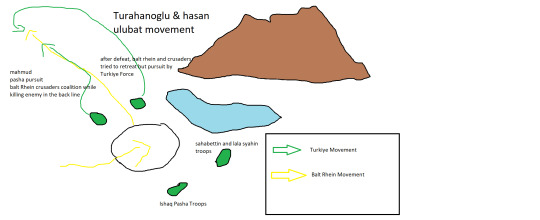
25th, month of Tuz. the crusaders arrived at Furullio but found the surroundings of the town empty of the ruins of the fort because of the manjaniq and cannon shelling of the Turkiye Troops. they continued to be forced to move towards Mahmud's troops. here the conditions of the crusaders began to become tired and hopeless, due to the authoritarian actions of some generals and commanders of the crusader coalition, stubbornly trying to pursue the enemy troops.
On the 28th, the crusaders attempted to seize water and grass for their horses in the Ashkavya valley. but suddenly the Turkiye troops shouted and surrounded them from all sides. fighting broke out that night. The crusaders continued to demoralize the crusaders with shouts of takbir and prayers. they burned straw and hay and showered the Balt Rhine troops with cannon and arrows. destroy their ballistae before they are even used.
in a state of panic the crusaders tried to form formations and tried to retreat in an orderly manner. but Mahmud Pasha did not let that happen, he chased the enemy troops and finished off those who were left behind. the two armies once again met in the Almanac.
Richard's main force struggled in a desperate state to survive the attacks of the Turkiye troops, as well as the attacks of the heavy cavalry troops. Richard ordered the Turtle Formation, but soon Turkish artillery troops arrived and destroyed the formation with artillery fire. after that the charge of the Turkiye cavalry came crashing down. many of Richard's men died without much resistance and the wounded and alive fell as prisoners. while Richard himself was killed at the hands of Mahmud. the Balt Rhein troops scattered, most of those who survived fled in an uncertain direction, some of them made it to the espada in tatters and even unarmed.
The Balts of the Rhein and the crusaders were defeated. The explanation for this eye sanction is that Ilyas Bey (Ilyas bin Abdullah), a Janissary soldier, witnessed the moments of the victory of the Turkiye troops in the Almanac. Quoted by Sukrullah Celebi:
"The general commander of the Balt Rhein troops stopped at the Almanac to finish their last resistance. The two armies attacked each other without mercy. While our commander (Mahmud Pasha) shouted, shoot the arrows at the demons!!!. Our cavalry archers!" advanced and fired their arrows while the enemy troops formed a phalanx. they could withstand our composite arrows, but not our gallant cannon fire. Their formation was broken and we continued to suppress and repel the enemy until Allah gave us victory."
Aftermath and Losses
casualties between the two sides could not be ascertained. however the Balt Rhine and the crusaders lost nearly half of their forces in this battle. the commander of the captured Balt Rhein forces, namely Vermandois, and barron Michell (currently the one identified). Hugh Geoffrey of bohemia, hugh Austrian. commander of the german troops, plivilain batron, and Hugh Gibrael. as well as several commanders from Italy, and Hungary. Among the captured Balt Rhine troops, about 600 or 700 people decided to convert to Islam, after an invitation from Mahmud Pasha. who was later released. as for the rest, it was decided to be sold as slaves. Mahmud Pasha asked his soldiers to treat the prisoners of the commander of the Balt Rhein properly. as for the commander of the crusaders outside the Rumelia peninsula. Mahmud asked his troops to beheaded all of them. assuming their presence in rumelia is far more dangerous than the Balt Rhein.
7 days after the victory at ashkavya, (4, month of Ak koyunlu year 77 of the Turkiye Calendar). Mahmud Pasha began to lay siege to Furullio and quickly took the city. as the Balt Rheins poured out of the city in droves. then, with an army of 40,000, Mahmud launched a siege on the city of Chielo. in the city there were only 1000 Hungarian soldiers defending the city. The Hungarian troops asked for security guarantees in exchange for the city's surrender, and they were able to leave the city safely. Mahmud agreed to this agreement. the defeat at Asykvya resulted in a weakening of the city's defenses which were controlled by the Balt Rhein. most of the soldiers, who had lost the battle, decided to flee further into the Rhein region. the big impact that was caused was that in just a few months, Mahmud Pasha succeeded in controlling the big cities in the Sud. such as Phoenicia, Espada, Humo, Seallant, Basque, Sirena, Almeja, Duna, Nina, Sal, Campana, and Scoglio.
News of the defeat at Ashkavya (the fall of Phoenicia was followed by the loss of the Sud region), was carried by Philip towards St. Michael, caused a huge stir in the Empire. Prime Minister Virigillio Louis attempted to mobilize a new expeditionary force to attack Turkiye head-on in hopes of avenging the painful defeat at the Sud. but ended with the defeat of their troops at Muchever. forced the Balt Rhein to sign a peace treaty with the Turkiye in Florence.

Timeline Sud military Expedition by Turkiye.
#shoukoku no altair#altair a record of battle#kotono kato#ottoman#tughril mahmut#fanfic#Altair; Era Of Crusades#kato kotono
2 notes
·
View notes
Text
Experience the Magic of a Rhine River Cruise and the Netherlands
A Rhine River Cruise and the Netherlands offer a unique blend of cultural immersion, scenic beauty, and historical exploration. This adventure provides travelers with the chance to journey through some of Europe’s most picturesque landscapes while exploring the rich heritage of the Netherlands.
Highlights of a Rhine River Cruise
Embarking on a Rhine River Cruise is like stepping into a fairytale. The cruise takes you through Germany, France, Switzerland, and the Netherlands, offering breathtaking views of medieval castles, rolling vineyards, and charming villages along the way. Each port of call presents an opportunity to delve into the local culture and history.
Classic Destinations Along the Rhine
One of the standout features of a Rhine River Cruise is the array of classic European destinations. Cities like Cologne, with its awe-inspiring Gothic cathedral, and Strasbourg, known for its half-timbered houses and vibrant markets, provide a glimpse into the region's rich past. The charming town of Heidelberg, with its historic university and imposing castle, is another highlight. As you cruise through the Middle Rhine Valley, you'll encounter the legendary Lorelei Rock and picturesque villages that seem frozen in time.
Discovering the Netherlands
The Netherlands, often the final stop on a Rhine River Cruise, is a country that captivates with its scenic beauty and vibrant culture. Amsterdam, the capital city, is renowned for its intricate canal system, world-class museums, and lively atmosphere. A visit to the Van Gogh Museum or the Anne Frank House offers profound insights into the country's artistic and historical legacy.
Scenic Beauty and Cultural Heritage
Beyond Amsterdam, the Netherlands boasts many other attractions. The windmills of Kinderdijk, a UNESCO World Heritage Site, provide a glimpse into the ingenious water management systems of the Dutch. The Keukenhof Gardens, with their stunning displays of tulips in spring, are a must-see. Exploring the Dutch countryside, with its charming villages and expansive fields, adds a delightful dimension to your journey.
Educational Opportunities: School Trips
A Rhine River Cruise and the Netherlands can also serve as an enriching experience for students. School trips that incorporate this itinerary provide educational opportunities that go beyond the classroom. Students can learn about European history, art, and geography firsthand. They can explore museums, historical sites, and cultural landmarks, enhancing their understanding of the world in a fun and engaging way.
Unique Travel Experiences: Camps and Exchanges
For those interested in more immersive travel experiences, combining a Rhine River Cruise with participation in camps and exchanges in the Netherlands can be incredibly rewarding. Camps and exchanges allow travelers, especially young people, to engage deeply with local communities, learn new skills, and forge lasting friendships. These programs provide a unique way to experience Dutch culture and the everyday life of its people.
Exploring Beyond Europe: Classic Patagonia
While a Rhine River Cruise and the Netherlands offer a quintessential European experience, travelers might also consider adventures beyond Europe, such as exploring Classic Patagonia. The stunning landscapes of Patagonia, with its towering mountains, glaciers, and unique wildlife, offer a completely different kind of travel experience. Combining trips to both Europe and South America can provide a diverse and enriching travel portfolio.
Plan Your Adventure with Viajes & Cruceros
To ensure a seamless and memorable journey, consider planning your Rhine River Cruise and the Netherlands adventure with Viajes & Cruceros. Their expertise in crafting personalized travel experiences will help you make the most of your trip, whether you are exploring the scenic Rhine or immersing yourself in the culture of the Netherlands.
In conclusion, a Rhine River Cruise and the Netherlands offer an unforgettable travel experience, combining the beauty of Europe's waterways with the rich cultural tapestry of the Netherlands. Whether you are a history enthusiast, a nature lover, or someone seeking unique educational opportunities, this journey has something to offer. Let Viajes & Cruceros guide you on this enchanting adventure.
#Beaches (Punta Cana / MIAMI)#Turkey / Cappadocia#Middle East / EGYPT / MOROCCO Tours#Car and Bus Rentals#Northern Lights in Canada and Scandinavia
0 notes
Text
Europe's Rivers & Castles 7 - Night Cruise
From the meandering Main to the UNESCO-designated Upper Middle Rhine Valley with its multitude of castles dotting its shores to the vineyard-clad hills of the Moselle, enjoy Europe at its most picturesque. Let the storybook villages—Bernkastel, Cochem and Wertheim—captivate you; and Rothenburg, located on the Romantic Road enchant you. Marvel at the world’s largest ceiling fresco in the Würzburg…
0 notes
Text
Once again, please read Middle Eastern history. The actual colonizers of the region were the ARABS, not the Jews. The Arab Conquest in the 7th century colonized an area that spanned from Persia to Morocco. Jews were always indigenous to the southern Levant. Ashkenazi Jews are descended from families who captured by the Romans and taken from Judea to Rome. They later went north and settled in the Rhine Valley. Do some historical research and stop listening to Hamas propaganda.
0 notes
Text

Burg Stahleck - DEUTSCHLAND
#stahleck#burg#schloss#castle#castillo#upper middle rhine valley#bacharach#rhineland palatinate#deutschland#germany#alemania#europe#europa
58 notes
·
View notes
Text

🇩🇪 Rüdesheim as Seen from Bingen's Rhine Harbour in the Southwest - a coloured aquatint by Johann Ludwig Bleuler, Aegidius Federle & Friedrich Salathé, created by 1840. Digitally restored and enhanced.
Rüdesheim is a town in Hesse, Bingen is in Rhineland-Palatinate. Both are part of the UNESCO World Heritage Site "Upper Middle Rhine Valley".
#Rüdesheim#Bingen#Johann Ludwig Bleuler#Aegidius Federle#Friedrich Salathé#Rhein#Rhine#Germany#RLP#Hessen#landscape#art#vintage#artwork#Mittelrhein#Mittelreintal#See The Rhine#drawing#vintage art#central europe#europe#deutschland#rheinland pfalz#world heritage#world heritage site
3 notes
·
View notes
Text
Enxhi Seli-Zacharias is the improbable frontperson of Germany’s far-right Alternative for Germany (AfD) party in Gelsenkirchen, a working-class, industrial city in western Germany’s Ruhr Valley. The 30-year-old politician and political scientist arrived in Gelsenkirchen at the age of 6, together with her family, as refugees from newly post-communist Albania. Today, she sits in the state parliament of North Rhine-Westphalia.
She is the kind of cheerleader the AfD will likely need to achieve its stated goal of passing the Christian Democrats as Germany’s most popular party and eventually coming to power. Seli-Zacharias is a first-generation immigrant who is explicitly aiming to rally support for the bombastically anti-migration, xenophobic party among Germany’s immigrant communities. It’s a voting bloc that AfD leaders believe has massive potential for their project.
Seli-Zacharias’s TikTok and YouTube clips—which regularly get six-digit likes—speak straight to an unlikely voter pool: the 8 million registered voters in Germany with a migration background, 14 percent of the total electorate, and growing. Nearly a third of the country’s population—24 million—has roots in recent migration, and that number climbs ever higher as immigration outpaces the negative native-German birthrate. Germany has to crack down hard on “illegal immigration,” Seli-Zacharias inveighs in dire tones, targeting migrants from Africa and the Middle East who she alleges regularly rob and rape upstanding Germans like herself and the many other good people in Germany who speak proper German, work hard, raise families, and respect the law.
Seli-Zacharias counts herself among the latter demographic as a heterosexual, law-abiding citizen who speaks perfect German. In the North Rhine-Westphalia parliament, Seli-Zacharias believes she represents other integrated immigrants when she blasts the “chaos” and “failure” of Germany’s recent refugee policies. Migration has become the No. 1 topic for German voters overall, according to polls. Studies have shown that it’s also the foremost concern of non-native German voters. At the height of last decade’s refugee crisis, one study showed that 40 percent of Germans with an immigrant background said they thought the country should take in fewer refugees, with a quarter saying it should stop all refugees from entering entirely. “This dissatisfaction [with immigration policies] is apparently greater among some of the people with foreign roots living here than is their fear of the AfD,” the weekly magazine Focus recently concluded.
These are the sentiments that Seli-Zacharias feeds. Germany’s Willkommenskultur (culture of hospitality) ”has reached its limit,“ she intones in her videos, most probably referring to the 350,000 foreign nationals who applied for political asylum in Germany in 2023. “No federal state should have to spend 640 million euros for people who don’t belong here in the first place,” she says, referring to North Rhine-Westphalia’s 2023 state budget for all aspects of immigration.
Germany’s political class is not entirely unaware of the phenomenon of people with immigrant backgrounds voting for anti-immigrant parties, although previously in drips and drabs. In a regional election in the federal state of Hesse in 2018, more naturalized immigrants voted for the Christian Democrats, Social Democrats and even the Greens than the AfD. But 14 percent of those with migration background did vote AfD, which is slightly higher than the share of Germany-born Germans (13 percent) who cast their ballots for the far right party. Experts like Sanem Kleff, director of a Berlin-based anti-racism NGO, argue that the AfD’s outreach to immigrants—in particular those hailing from Turkey and eastern Europe—has just begun and could pay off bigtime for the party.
Experts say there are several reasons for the affinity that some immigrant voters feel for this anti-immigrant party. One reason is their overlap on illiberal social views. “Just because a person moves from point A to point B doesn’t mean they leave their political socializations behind,” says Kleff, who was born in Turkey and raised in northern Germany. “Many come from deeply patriarchal cultures and are very conservative and nationalistic. In Turkish elections, the Turkish population in Germany overwhelmingly votes hard-right conservative,” Kleff told Foreign Policy.
Research on the political views of Germany’s diverse migrant communities is spotty, but the existing data supports Kleff’s claim. A 2016 University of Applied Sciences HMKW study found that although many newcomers expressed a desire to learn the German language and fit in, “there are clear differences between the refugees and the German majority society, namely in illiberal attitudes toward (homo)sexuality, marriage and partnerships, and even towards living arrangements such as shared flats. A worrying number of refugees agree with right-wing populist, authoritarian statements,” concluded the report. The report found that the values of many refugees “in key political areas are most similar to those of AfD supporters or the [right populist] Pegida movements.” Many voters with migration background also came to the AfD through the anti-vax movement, which perpetuated an array of conspiracy theories. The far right—in Germany and across Europe—has woven many of them into its ranks, experts say.
But the immigrant voters who support the AfD may have material motivations as well. Many immigrants fit the socioeconomic profile of the white German AfD voter. It’s not just that LGBTQ issues, feminism, and climate protection tend to be anathema to them. They are middle or lower-middle class people who are worried about losing what material security they have. They are alarmed about the confluence of crises that beset the German economy and see the future bleakly. They want to pay less taxes and desire job security. Newcomers are competition for them in the low-wage job market and in Germany’s increasingly strained housing market.
The “us versus them” mentality among older immigrant groups in Germany may also be fueled by a divergence in their respective paths to Germany and resentment at the perceived advantages enjoyed by the new arrivals. The German government has introduced various policies in recent years to help integrate refugees, including welfare payments, free language courses, and special university enrollment programs. Many of the 3 million people of Turkish descent living in Germany, meanwhile, recall having to struggle to keep their heads above water in their new home country. After arriving as “guest workers” in the 1960s or 1970s, they and their descendants received relatively little support from the German government —only to be later blamed by Germans for an alleged failure to integrate.
But voters with immigrant background tend not to acknowledge that the AfD may pose a material threat to them as well—even to their very presence in Germany. The AfD has long referred to the non-ethnic German citizens as “passport Germans,” that is, foreigners (wrongfully) possessing German passports. Moreover, the AfD’s Islamophobia and folkish German racism are defining characteristics of a hard-right party even more radical that many of its European peers. Some AfD leaders speak openly about plans to “re-migrate” up to 25 million foreigners, including those holding German passports, like Seli-Zacharias.
But Seli-Zacharias and like-minded AfD stalwarts turn a blind eye to these sorts of extremism. It is only fresh waves of migration that Seli-Zacharias wants to stop and “criminal foreigners” that she wants to expel. Seli-Zacharias underscores that she is thankful and respectful of the generosity Germany has shown her and her family.
“Perhaps subconsciously, they think that if they act like native Germans they won’t get thrown out themselves,” Naika Foroutan, director of the German Center for Integration and Migration Research, explained to German media. “They want to believe that the AfD doesn’t see them as the problem—you belong to us, they hear—but the others, they are the problem,” Foroutan said.
“The AfD has been very clever in the way it reaches out to immigrants, particularly the Russian Germans and those with Turkish background,” Kleff says. Since the 1980s, 2.3 million ethnic Germans have emigrated to Germany from Russia. The AfD has been the only German party to address them, and they did it first with Russia-language campaign materials, Kneff says, noting that many of the Russian Germans couldn’t speak German upon their arrival.
German voters with Turkish roots are the second immigrant bloc that AfD pragmatists have in their sights: It is a potentially growing group, due to a recently passed dual-citizenship law that could allow more people of Turkish descent to become German voters. Attracting these voters is a goal that the entire party has not yet officially endorsed. On the contrary, party fundamentalists insist that the AfD and Germany as such must be ethnically homogenous—namely white, German, and Christian. But by emphasizing an aversion to “Arabs” and not the larger category of “Muslims,” which would include most Turkish-background people, the AfD separates the two voter groups from each other and opens up a door for the latter.
Kleff notes that in Turkey itself, there is enormous animosity toward the 3.6 million Syrian refugees who live there, who are referred to by many Turks simply as “Arabs.” Low-income, work-a-day Turks fear that the refugees, who work for lower wages, could take their jobs from them—leaving them with nothing. The same goes for those in Germany.
Once the AfD gets its pitch down, Kleff says that more immigrants will go its way. Germany’s democratic parties look as incapable as ever of talking to the country’s integrated immigrants as a constituency that deserves to be taken seriously.
1 note
·
View note
Text

St. Mary's Cathedral and St. Michael's Church at Hildesheim



The Architectural Work of Le Corbusier, an Outstanding Contribution to the Modern Movement
Town Hall and Roland on the Marketplace of Bremen
Town of Bamberg

Upper Middle Rhine Valley

Völklingen Ironworks

Wadden Sea

Wartburg Castle

Water Management System of Augsburg

Würzburg Residence with the Court Gardens and Residence Square
Deutschribing Germany
Landmarks
Germany is the third country in the world with the highest number of World Heritage Sites: fifty-one in total, of which forty-eight are cultural and three are natural.

Aachen Cathedral
The Aachen Cathedral is a Roman Catholic church in Aachen, North Rhine-Westphalia. It is one of the oldest cathedrals in Europe and was consecrated in 805. Emperor Charlemagne was buried there.
The cathedral has two distinct architectural styles and small portions of a third. The core is Carolingian-Romanesque, the choir was constructed in the Gothic style, and the area around the throne is Ottonian.
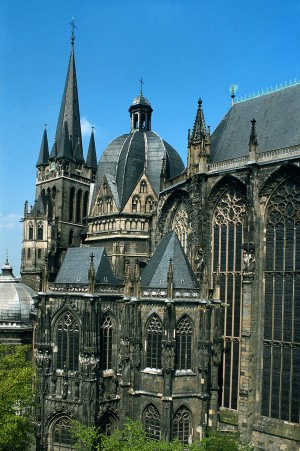
Abbey and Altenmünster of Lorsch
The Lorsch Abbey is a former imperial abbey in Lorsch, Hesse. It was founded in 764 and was one of the most renowned monasteries of the Carolingian Empire. Although in a ruined state nowadays, its remains are among the most important pre-Romanesque-Carolingian style.
The abbey combines the Roman triumphal arch (arch-shaped passageways and half-columns) with the vernacular Teutonic heritage (baseless triangles of the blind arcade and polychromatic masonry).

Ancient and Primeval Beech Forests of the Carpathians and Other Regions of Europe
The Ancient and Primeval Beech Forests of the Carpathians and Other Regions of Europe is a transnational serial nature site that includes forests in Albania, Austria, Belgium, Bulgaria, Croatia, Germany, Italy, Romania, Slovakia, Slovenia, Spain, and Ukraine.
It encompasses 94 forests of European beech, which in many cases have grown without interference since the last ice age. Those in Germany are located in Brandenburg, Hesse, Mecklenburg-Vorpommern, and Thuringia.
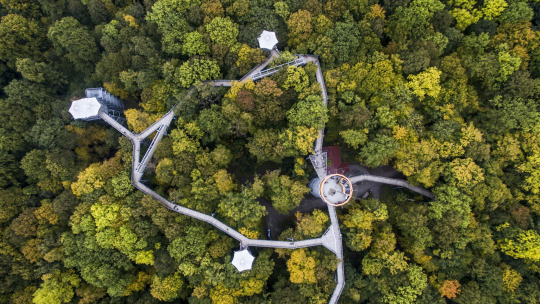
Archaeological Border complex of Hedeby and the Danevirke
Hedeby was an important Danish Viking Age trading settlement between the 8th and 11th centuries, now in Busdorf, Schleswig-Holstein. It was rediscovered in the late 19th century.
The Danevirke or Danework is a system of Danish fortifications in Schleswig-Holstein initiated in 650 and expanded during the Viking Age and High Middle Ages.

Bauhaus and its Sites in Weimar, Dessau and Bernau
Bauhaus and its Sites in Weimar, Thurngia; Dessau-Roßlau, Saxony-Anhalt, and Bernau bei Berlin, Brandenburg, comprises six separate sites associated with the Bauhaus art school, which was in operation between 1919 and 1933.
The buildings are fundamental representatives of Classical Modernism and Art Nouveau. Some of them were built as social housing, others operated as schools, and the rest of them were residential buildings.
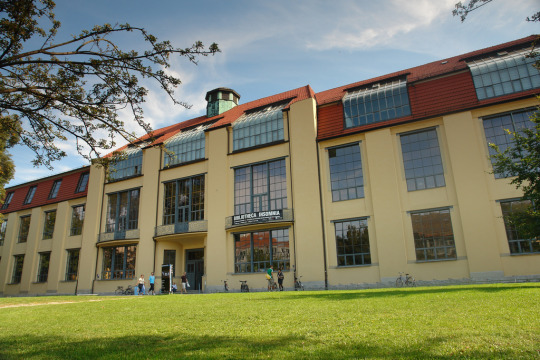
Bergpark Wilhelmshöhe
Bergpark Wilhelmshöhe is a landscape park in Kassel, Hesse. It is the largest European hillside park and the second-largest park on a hill slope in the world. Construction began in 1689 and lasted 150 years.
The park has Baroque buildings and unique fountains and water features. At the summit stands the Hercules monument, a 40-meter-high pyramid with an 8.5 meter bronze statue of Hercules.

Berlin Modernist Housing Estates
The Berlin Modernist Housing Estates site comprises six separate subsidized housing estates in Berlin. It dates from the Weimar Republic (1919-1933).
The estates are examples of the building reform movement that contributed to improving housing and living conditions of people and also provide exceptional examples of new urban and architectural typologies, as well as technical and aesthetic innovations.

Carolingian Westwork and Civitas Corvey
The Princely Abbey of Corvey is a former Benedictine abbey consecrated in 844 and located in Höxter, North Rhine-Westphalia. It was one of the self-ruling princely abbeys of the Holy Roman Empire.
An example of Carolingian architecture, it is the oldest surviving example of a westwork, whose inside contains the only known wall paintings of ancient mythology with Christian interpretation in Carolingian times.

Castles of Augustusburg and Falkenlust at Brühl
The Ausgustusburg and Falkenlust Palaces form a historical building complex in Brühl, North Rhine-Westphalia. The buildings are connected by the spacious gardens of the Schlosspark.
Built in the early 18th century, the palaces and gardens are masterpieces of early Rococo architecture. They are now used as a venue for concerts.

Caves and Ice Age Art in the Swabian Jura
The Caves and Ice Age Art in the Swabian Jura are a collection of six caves in the Swabian Alps, in Baden-Württemberg, which were used by Ice Age humans for shelter about 33,000 to 43,000 years ago.
Within the caves were found the oldest non-stationary works of human art in the form of carved animal and humanoid figurines, in addition to the oldest musical instruments ever found.
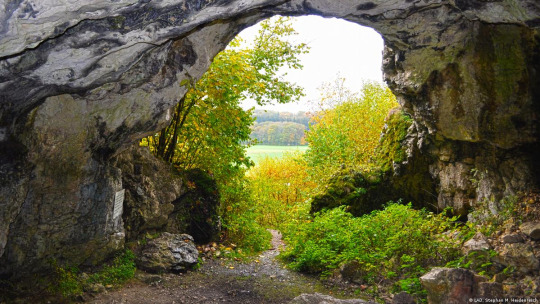
Classical Weimar
Classical Weimar consists of eleven sites in and around Weimar, Thuringia. The city was a cultural center of the Enlightenment during the 18th and 19th centuries, where many notable writers and philosophers, including Christoph Martin Wieland, Friedrich Schiller, John Gottfried Herder, and Johann Wolfgang von Goethe, lived and participated in the Weimar Classicism movement.
It includes the church of St. Peter and Paul, Duchess Anna Amalia Library, Goethe's house, Herders residence, the historical cemetery, Park an der Ilm, Schiller's house, Schloss Belvedere, Schloss Ettersburg, Schloss Weimar, Tiefurt House, Wilhelm-Ernst-Gymnasium, and Wittumspalais.
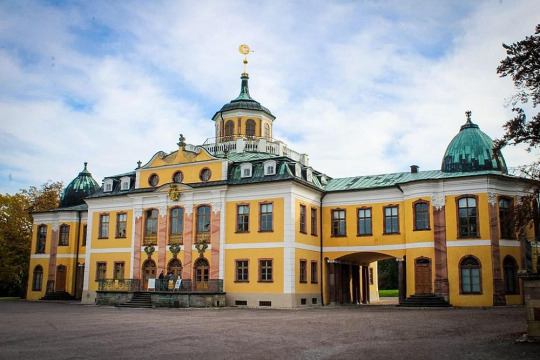
Collegiate Church, Castle, and Old Town of Quedlinburg
Quedlinburg was an influential and prosperous trading center during the early Middles Ages and a center of influence under the Ottonian dynasty.
Quedlinburg Abbey was a house of secular canonesses in Quedlinburg, Saxony-Anhalt. It was founded in 936 on the initiative of Saint Mathilda, the widow of King Henry the Fowler, as his memorial. The castle, abbey, church, and surrounding buildings are masterpieces of Romanesque architecture.

Cologne Cathedral
The Cologne Cathedral is a Catholic cathedral in Cologne, North Rhine-Westphalia. Construction began in 1248 but was halted in 1560; the cathedral was not completed until 1880.
It is a renowned monument of Gothic architecture and the largest Gothic church in Northern Europe, with the second-tallest spires. It is also the third-tallest church in the world.

Darmstadt Artists' Colony Mathildenhöhe
The Darmstadt Artists' Colony refers to a group of Jugendstil artists as well as to the buildings in Mathildenhöhe in Darmstadt, Hesse, where the artists lived in the 19th and 20th centuries.
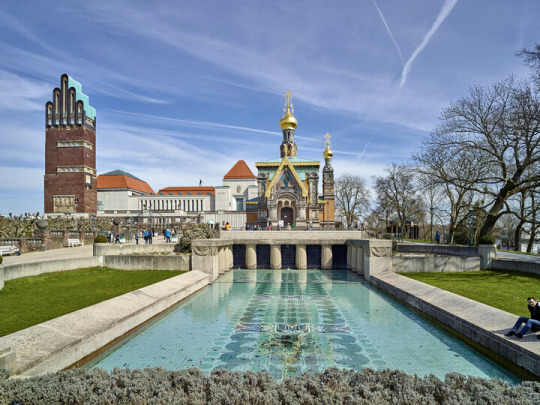
They were financed by patrons and worked together with other members of the group with similar artistic tastes.
Erzgebirge/Krušnohoří Mining Region
The Ore Mountains—Erzgebirge in German and Krušnohoří in Czech—lie along the Czech-German border in Bohemia and Saxony, respectively, and the site is shared between the Czech Republic and Germany.
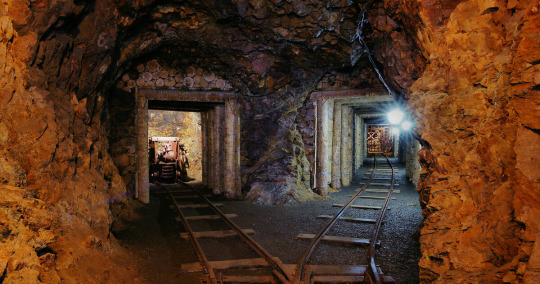
The region was the setting of the earliest stages of the early transformation of mining and metallurgy from a craft to a large-scale industry. As a result, mining directly shaped the landscape and the habitats of plants and animals.
Fagus Factory in Alfeld
The Fagus Factory is a shoe last factory in Alfeld on the Leine, Lower Saxony. It is an important example of early modern architecture.

The factory was commissioned by Carl Benscheidt, who wanted a radical structure that expressed the company's break from the past. It was built between 1911 and 1913.
Frontiers of the Roman Empire
Limes is the term used to refer to the Germanic border defense or delimiting system marking the borders of the Roman Empire and separating the empire from the unsubdued Germanic tribes between the years 83 and 260.
The Limes Germanicus are the fortifications that bounded the ancient Roman provinces of Germania Inferior, Germania Superior, and Raetia, in modern-day southwestern North Rhine-Westphalia and southwestern and southern Germany. Their total length was 568 km, and they included sixty forts and 900 watchtowers.
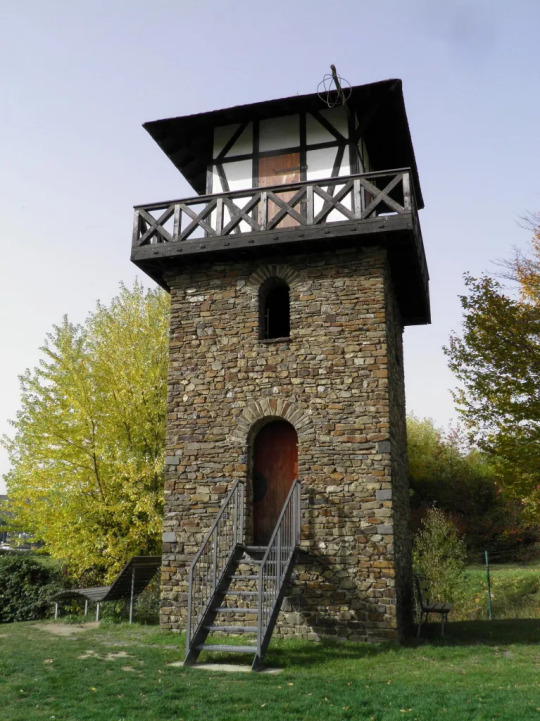
Frontiers of the Roman Empire in Bavaria
The Danubian Limes refers to the Roman military frontier along the Danube in Bavaria, as well as Austria, Bulgaria, Croatia, Hungary, Romania, Serbia, and Slovakia.
The border was reinforced with watchtowers, legion camps, and forts built around the first century. A Roman road, the Danube Way, was laid along the limes.

Garden Kingdom of Dessau-Wörlitz
The Dessau-Wörlitz Garden Realm is a cultural landscape between Dessau and Wörlitz in Saxony-Anhalt. It was created in the late 18th century and is one of the largest English parks in continental Europe.

It was designated as a world heritage site because of its exceptional landscape design and testimony to the ideals of the Enlightenment Age.
Great Spa Towns of Europe
The Great Spa Towns of Europe is a transnational site that includes eleven spa towns across several European countries, namely, Austria, Belgium, Czech Republic, France, Germany, Italy, and the United Kingdom.
Those in Germany are Bad Ems, Rhineland-Palatinate; Baden-Baden, Baden-Württemberg, and Bad Kissingen, Bavaria. All the spa towns were developed around natural mineral water springs.

Hanseatic City of Lübeck
The Hanseatic City of Lübeck, located in Schleswig-Holstein, is the second-largest city on the German Baltic coast. It was founded before 819 by Polabian Slavs and became the cradle and capital city of the Hanseatic League.
Nicknamed the "City of Seven Towers", its historic old town includes five Protestant churches with seven towers: the Lübeck Cathedral, St. Giles's, St. Jacob's, St. Mary's, and St. Peter's, as well as the Burgkloster, the Koberg site, the town hall, and the market square.

Historic Centers of Stralsund and Wismar
The Hanseatic City of Stralsund is located in Mecklenburg-Western Pomerania and is the oldest city in Pomerania. The Strelasund Crossing connects the city with Rügen, the largest island of Germany. Its old town was inscribed as a UNESCO World Heritage Site alongside Wismar because of its Brick Gothic buildings and importance in the Hanseatic League.
The Hanseatic City of Wismar is also located in Mecklenburg-Western Pomerania. Its historical old town includes the churches of St. George's, St. Mary's, and St. Nicholas's.

Luther Memorials in Eisleben and Wittenberg
Eisleben, in Saxony-Anhalt, was the hometown of Martin Luther, and he even preached his last sermon and died there. His Birth and Death houses are a UNESCO World Heritage Site. The town was first mentioned in the late 10th century.
Wittenberg is also famous for its close connection with Luther, as he lived in the Augustinian monastery. It was also one of the most powerful cities in the Holy Roman Empire as the seat of the Elector of Saxony.
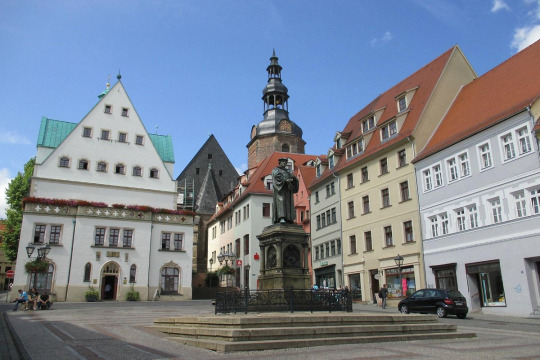
Margravial Opera House Bayreuth
The Margravial Opera House is a Baroque opera house in Bayreuth, Bavaria. It was constructed according to the plans designed by the French architect who built the court of Hohenzollern margrave Frederick of Brandenburg-Bayreuth.
The façade was inspired by the Place Vendôme in Paris and has large Corinthian columns. A balustrade is stretched across the façade, with sculptures of Apollo, Minerva, and six Muses placed atop.

Maulbronn Monastery Complex
The Maulbronn Monastery is a former Cistercian abbey and ecclesiastical state in Maulbronn, Baden-Württemberg.

Founded in 1147, the complex is surrounded by turreted walls and a tower gate. Today it houses the town hall and a police station. The monastery contains an Evangelical seminary and a boarding school.
Messel Pit Fossil Site
The Messel pit is a quarry near Messel, in Hesse. Before it fell into disuse, bituminous shale was mined there. Besides its mineral significance, it also has significant geological and scientific importance due to the abundance of well-preserved fossils and diversity of plants and animals found there.

The site almost became a landfill, but strong local resistance stopped these plans and the site was declared a World Heritage Site. Since then, discoveries about the early evolution of mammals and birds are still being made.
Mines of Rammelsberg, Historic Town of Goslar and Upper Harz Water Management System
The Rammelsberg is a mountain south of Goslar, Lower Saxony, where an important silver, copper, and lead mine is located. Before its closure in 1988, it was the only mine still working continuously for over 1,000 years.
Goslar's political importance for the Holy Roman Empire and its testimony to the history of ore mining contributed to making them a UNESCO World Heritage Site. The Upper Harz Water Regale is a system of dams, reservoirs, and ditches built between the 16th and 19th centuries to store the water that drove the water wheels of the mines, including those in Rammelsberg.

Monastic Island of Reichenau
The Reichenau Island is located in Lake Constance, Baden-Württemberg. It is connected to the mainland by a causeway and a low road bridge.
In 724, the first monastery was built on the island, and Reichenau became an influential religious, cultural, and intellectual center. The Reichenau Abbey was one of the most significant monasteries in the Frankish Empire.

Museum Island, Berlin
The Museum Island in Berlin is a museum complex on the northern part of the Spree Island. It was built between 1830 and 1930 by order of the Prussian kings.
The island consists of the Altes Museum (old museum), Neues Museum (new museum), Alte Nationalgalerie (old national gallery), the Bode-Museum, and the Pergammonmuseum, as well as the Berlin Cathedral.
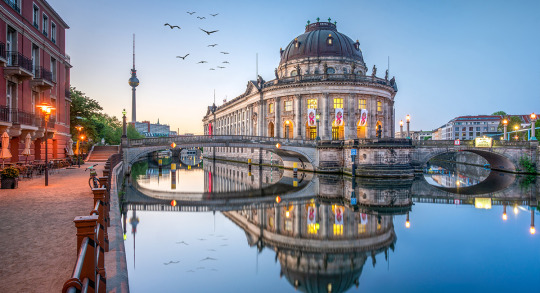
Muskauer Park/Park Mużakowski
The Muskau Park—Muskauer Park in German and Park Mużakowski in Polish—is a landscape park in Upper Lusatia, a region between Germany (Saxony) and Poland.
The site forms the largest English gardens in Central Europe and was laid out from 1815 onward. Its utopian design incorporates both native plants and the nearby town.
Naumburg Cathedral
The Naumburg Cathedral is located in Saxony-Anhalt. It dates from the 13th century and is a renowned landmark of the German Romanesque.
The west choir, the donor portrait statues of the twelve founders, and the rood screen are significant early Gothic monuments.
Old Town of Regensburg with Stadtamhof
Regensburg, in Bavaria, was an imperial Roman river fort and the political, economic, and cultural center of the surrounding region.
Its medieval center was made a World Heritage Site because of its well-preserved architecture, being the biggest medieval city north of the Alps, and historical importance for assemblies during the Holy Roman Empire.
Palaces and Parks of Potsdam and Berlin
The Palaces and Parks of Potsdam and Berlin site is a group of palace complexes and landscaped gardens in the Havelland region around Berlin and Potsdam.
Among others, the site includes the Palace and Park of Sanssouci, Neuer Garten (New Garden), Marmorpalais (Marble Palace), Cecilienhof Palace, Glienicke Palace, Park Glienicke, Nikolskoe log house, Pfaueninsel (Peacock Island), and Jagdschloß Glienicke (Glienicke hunting lodge).
Pilgrimage Church of Wies
The Pilgrimage Church of Wies is an oval Rococo church located in the foothills of the Alps in the town of Steingaden, Bavaria. It was built in the late 1740s by the Zimmermann brothers after a miracle allegedly happened there.
In 1738, tears were seen on a wooden figure of Christ at the Column. This resulted in a pilgrimage rush to see the sculpture, which led to the construction of a small chapel to house the statue. The chapel was soon expanded due to the large number of pilgrims it attracted.
Prehistoric pile dwellings around the Alps
The prehistoric pile dwellings around the Alps are a series of prehistoric stilt houses settlements in the Alps built between 5,000 and 500 BCE on the edges of lakes, rivers, or wetlands.
The UNESCO site includes 111 dwellings in Switzerland (56), Italy (19), Germany (18), France (11), Austria (5), and Slovenia (2). Excavations conducted at some of the sites have yielded important evidence regarding prehistoric life.
Roman Monuments, Cathedral of St. Peter and Church of Our Lady in Trier
The Roman Monuments, Cathedral of St. Peter and Church of Our Lady in Trier, Rhineland-Palatinate, demonstrate the political, economic, and historical importance of Trier in the Roman Empire.
The site includes the Aula Palatina, Barbara Baths, Church of Our Lady, High Cathedral of Saint Peter, Igel Column, Imperial Baths, Moselle Bridge, and Porta Nigra.
ShUM cities of Speyer, Worms and Mainz
The ShUM cities site refers to three Jewish communities in Rhineland-Palatinate: Shpira (Speyer), Warmaisa (Worms), and Magenza (Mainz). They were cultural centers of Jewish scholarship and of great importance for Ashkenazi Judaism.
Speyer contains some of the oldest and best-preserved Jewish buildings in its Jewish courtyard, while Worms has the oldest surviving in situ cemetery in Europe. Unfortunately, the city of Mainz, like many other places around the world, was the site of persecution and massacres against Jewish people.
Speicherstadt and Kontorhaus District
The Speicherstadt ("City of Warehouses") and Kontorhaus District are located in Hamburg. The Speicherstadt, where buildings stand on oak-pile foundations, is the largest warehouse district in the world. An example of Neo-Gothic and modernist architecture, the district was built as a free zone to transfer goods without paying customs.
The Kontorhaus District is the southeastern part of the old town. It is characterized by large office buildings in the style of Brick Expressionism. The area is densely built-up with many narrow alleys.
Speyer Cathedral
The Imperial Cathedral Basilica of the Assumption and St. Stephen is located in Speyer, Rhineland-Palatinate. The cathedral was built in the 11th century and features a triple-aisled vaulted basilica of red sandstone.
It is the largest Romanesque church in the world and is the burial site of several Salian, Hohenstaufen, and Habsburg emperors and kings.
St. Mary's Cathedral and St. Michael's Church at Hildesheim
The Cathedral of the Assumption of Mary is a medieval Roman Catholic cathedral in Hildesheim, Lower Saxony. It was built between 1010 and 1020 in the Romanesque style.
The Church of St. Michael is an early-Romanesque church in Hildesheim. Built in the 11th century, it is now a shared church, the main church being Lutheran and the crypt being Roman Catholic.
The Architectural Work of Le Corbusier, an Outstanding Contribution to the Modern Movement
The Architectural Work of Le Corbusier site consists of seventeen Modernist buildings in three continents by architect Le Corbusier.
The Weissenhof Estate is a housing estate in Stuttgart, Baden-Württemberg, and one of Le Corbusier's designs. It was built for an exhibition to showcase modern architecture's aspiration to provide cheap, simple, efficient, and good-quality housing.
Town Hall and Roland on the Marketplace of Bremen
The Bremen City Hall is one of the most important examples of Brick Gothic and Weser Renaissance architecture in Europe. Built in the 15th century, it is located on the market square.
Directly in front of it is the statue of Roland, which depicts the paladin of the first Holy Roman Emperor Charlemagne and hero of the Battle of Roncevaux Pass. It was erected in 1404 and the oldest surviving example.
Town of Bamberg
Bamberg is a town in Bavaria that dates back to the 9th century. It was a key link with the Slavs, especially those of Pomerania and Poland, and was briefly the center of the Holy Roman Empire.
Its medieval streets and buildings and historical significance were behind its designation as a UNESCO World Heritage Site.
Upper Middle Rhine Valley
The Upper Middle Rhine Valley or Rhine Gorge is a 65 km section of the Rhine between Koblenz and Rüdesheim in Rhineland-Palatinate and Hesse.
The rocks that form the landscape were laid down during the Paleozoic era and are known as Rhenish Facies, a type of fossil-bearing sedimentary rock mainly consisting of slate.
Völklingen Ironworks
The Völklingen Ironworks is a former blast-furnace complex in Völklingen, Saarland. Pig or crude iron production occurred at the site between 1882 and 1986.
It is one of the few intact ironworks surviving in Europe and North America and a testimony to ferrous metallurgy and the Industrial Revolution.
Wadden Sea
The Wadden Sea is an intertidal zone in the southeastern part of the North Sea, which borders Bremen, Hamburg, Lower Saxony, and Schleswig-Holstein.
It lies between northwestern continental Europe and the low-lying Frisian Islands, forming a shallow body of water with tidal flats and wetlands. The site has a high biological diversity and is an important area for breeding and migrating birds.
Wartburg Castle
The Wartburg is a medieval castle in Eisenach, Thuringia. It was the home of St. Elisabeth of Hungary and the place where Martin Luther translated the New Testament.
The castle's structures date from the 12th through 15th centuries, but the interior only goes back to the 19th century. It was an important inspiration for the Neuschwanstein Castle.
Water Management System of Augsburg
The Water Management System of Augsburg is located in the city of Augsburg, Bavaria, which is one of Germany's oldest cities, founded by the Romans.
The city's water management system has unique medieval canals and water towers and is testimony to the development of hydraulic engineering.
Würzburg Residence with the Court Gardens and Residence Square
The Würzburg Residence is a palace in Würzburg, Bavaria, whose interiors are masterworks of Baroque and Rococo architecture and art, including the largest fresco in the world.
Built in the 18th century, the residence includes large gardens in the Baroque and English garden styles.
Zollverein Coal Mine Industrial Complex
The Zollverein Coal Mine Industrial Complex is a former industrial site in Essen, North Rhine-Westphalia. The first mine was founded in 1847 and the last one closed in 1986.
The two parts of the site ranked among the largest of their kinds in Europe and were built in the New Objectivity style.
13 notes
·
View notes